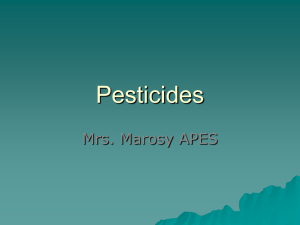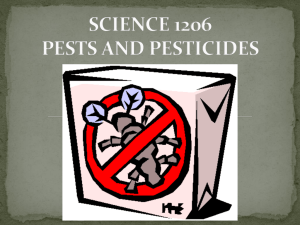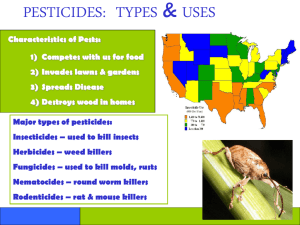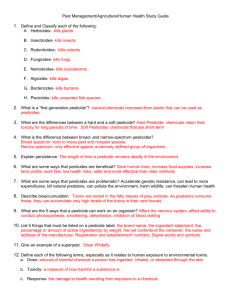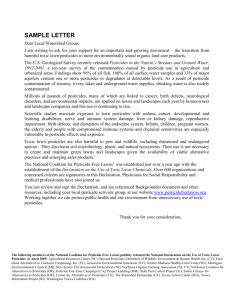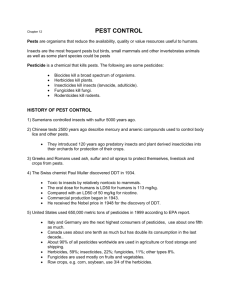Pesticides - ChemicalInjury.net
advertisement
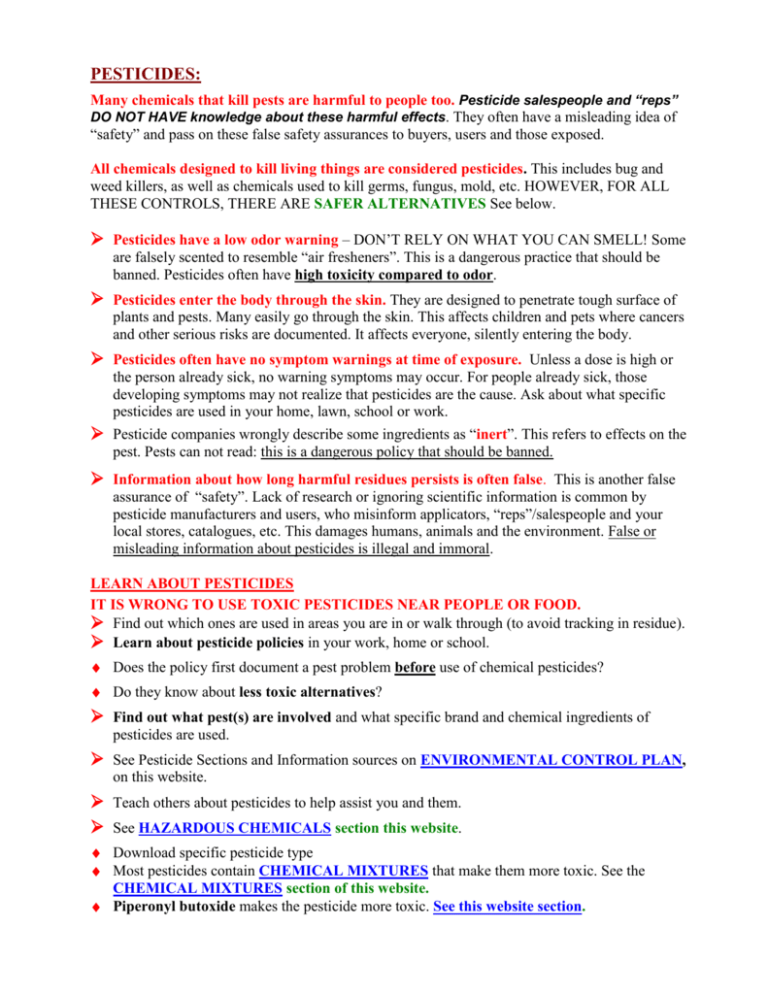
PESTICIDES: Many chemicals that kill pests are harmful to people too. Pesticide salespeople and “reps” DO NOT HAVE knowledge about these harmful effects. They often have a misleading idea of “safety” and pass on these false safety assurances to buyers, users and those exposed. All chemicals designed to kill living things are considered pesticides. This includes bug and weed killers, as well as chemicals used to kill germs, fungus, mold, etc. HOWEVER, FOR ALL THESE CONTROLS, THERE ARE SAFER ALTERNATIVES See below. Pesticides have a low odor warning – DON’T RELY ON WHAT YOU CAN SMELL! Some are falsely scented to resemble “air fresheners”. This is a dangerous practice that should be banned. Pesticides often have high toxicity compared to odor. Pesticides enter the body through the skin. They are designed to penetrate tough surface of plants and pests. Many easily go through the skin. This affects children and pets where cancers and other serious risks are documented. It affects everyone, silently entering the body. Pesticides often have no symptom warnings at time of exposure. Unless a dose is high or the person already sick, no warning symptoms may occur. For people already sick, those developing symptoms may not realize that pesticides are the cause. Ask about what specific pesticides are used in your home, lawn, school or work. Pesticide companies wrongly describe some ingredients as “inert”. This refers to effects on the pest. Pests can not read: this is a dangerous policy that should be banned. Information about how long harmful residues persists is often false. This is another false assurance of “safety”. Lack of research or ignoring scientific information is common by pesticide manufacturers and users, who misinform applicators, “reps”/salespeople and your local stores, catalogues, etc. This damages humans, animals and the environment. False or misleading information about pesticides is illegal and immoral. LEARN ABOUT PESTICIDES IT IS WRONG TO USE TOXIC PESTICIDES NEAR PEOPLE OR FOOD. Find out which ones are used in areas you are in or walk through (to avoid tracking in residue). Learn about pesticide policies in your work, home or school. Does the policy first document a pest problem before use of chemical pesticides? Do they know about less toxic alternatives? Find out what pest(s) are involved and what specific brand and chemical ingredients of pesticides are used. See Pesticide Sections and Information sources on ENVIRONMENTAL CONTROL PLAN, on this website. Teach others about pesticides to help assist you and them. See HAZARDOUS CHEMICALS section this website. Download specific pesticide type Most pesticides contain CHEMICAL MIXTURES that make them more toxic. See the CHEMICAL MIXTURES section of this website. Piperonyl butoxide makes the pesticide more toxic. See this website section. Pesticide residue goes through the fruit, vegetable, etc. and cannot be removed by scrubbing the outside. Pesticides become more concentrated in animals fed with pesticide – using crops. EATING PESTICIDES IN FOOD INCREASES RISK OF SERIOUS ILLNESS. Work for and seek out safer foods, Foods grown with natural fertilizers are also higher in nutrients – a good health investment. LEARN ABOUT NON TOXIC PEST CONTROL ALTERNATIVES For example, Dr. Ziem has effectively used boric acid for many pests. Use in ways that are not vacuumed or come into contact with food or food areas. Boric acid is tracked back to the nest, killing pests other chemicals don’t reach. Boric acid remains, killing pests for months or even years. It does not evaporate. Dr. Ziem has used it effectively as: Paste for roaches and other crawling bugs. Mixed with sugar (or as Terro Brand) at the location where ants enter. As a spray mixed with water (avoid breathing) for wasp nests, outdoor pests, etc. As a powder outdoors – eg millipedes, etc. Pets – you can consider: Outdoors straw, cypress bark mulch, cedar chips Indoors – if not sensitive – cedar chips in pet bed, diatomaceous earth in a dog bed. Slowly add “Brewers yeast” to pet food. It is excreted out pores. Fleas, etc. dislike it. Final dose ½ tsp for cats, dose dogs depending on size: not over 1 Tbs/day. Other Ideas See Controlling Neighborhood Pesticide Exposure and Safer Pest Control, (Environmental Control Plan) listed on this website Arbico for horse, cattle, other livestock controls (800-827-2847 or www.arbico.com Pets: www.arbico.com and/or www.springtime.com Gardens Alive (513-35401482 or www.gardensalive.com Food Sources without pesticides See Appendix in Endangered Brains, Princeton Scientific Pub., 2004 Contact Organic Consumers Association www.organicconsumers.org Northeast Farming Organization www.nofa.org Center for Food Safety www.centerforfoodsafety.org Sea Food Watch (Monteray Bay) www.mbay.org/cr/seafoodwatch.asp Beyond Pesticides www.beyondpesticides.org, to learn about pesticide food labeling policies, laws; safer sources.



